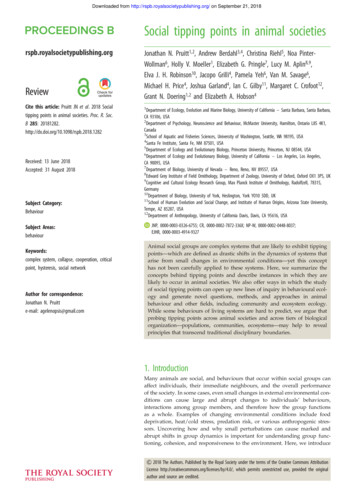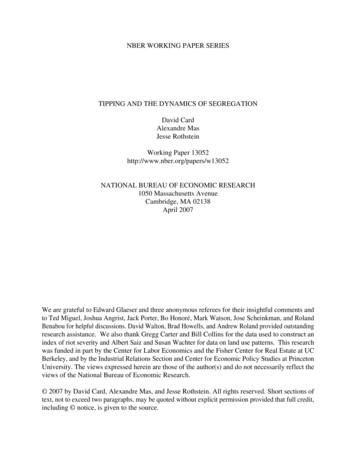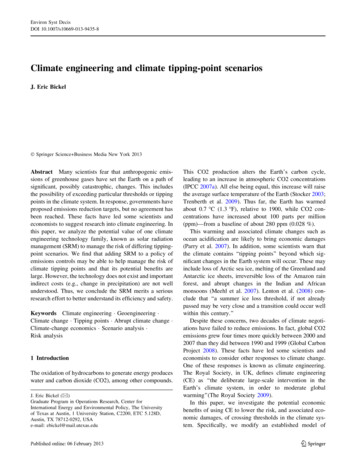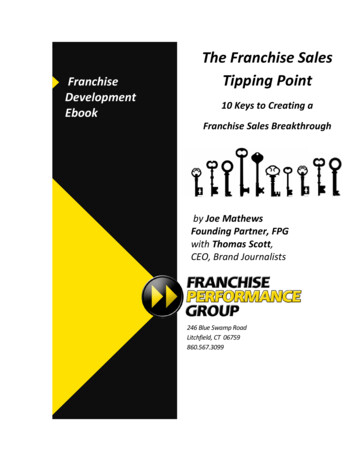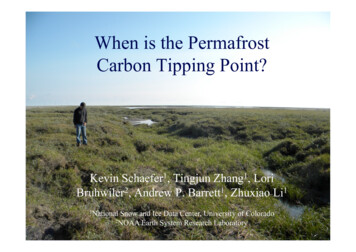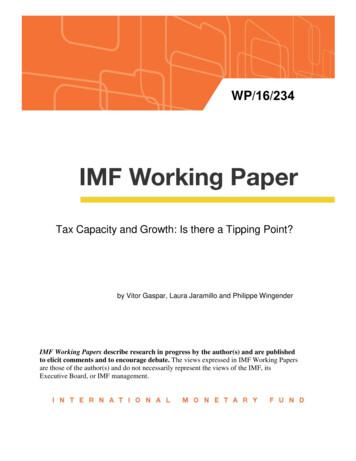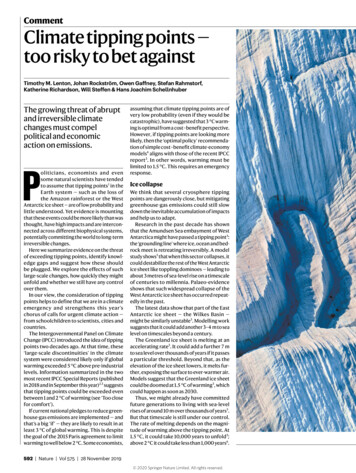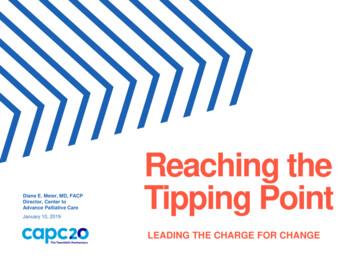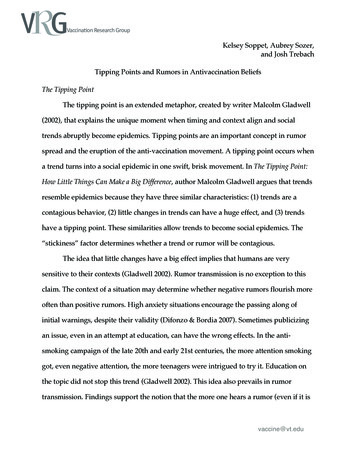
Transcription
!"## %"&'%()* *",#-(.,'/0Kelsey Soppet, Aubrey Sozer,and Josh TrebachTipping Points and Rumors in Antivaccination BeliefsThe Tipping PointThe tipping point is an extended metaphor, created by writer Malcolm Gladwell(2002), that explains the unique moment when timing and context align and socialtrends abruptly become epidemics. Tipping points are an important concept in rumorspread and the eruption of the anti-vaccination movement. A tipping point occurs whena trend turns into a social epidemic in one swift, brisk movement. In The Tipping Point:How Little Things Can Make a Big Difference, author Malcolm Gladwell argues that trendsresemble epidemics because they have three similar characteristics: (1) trends are acontagious behavior, (2) little changes in trends can have a huge effect, and (3) trendshave a tipping point. These similarities allow trends to become social epidemics. The“stickiness” factor determines whether a trend or rumor will be contagious.The idea that little changes have a big effect implies that humans are verysensitive to their contexts (Gladwell 2002). Rumor transmission is no exception to thisclaim. The context of a situation may determine whether negative rumors flourish moreoften than positive rumors. High anxiety situations encourage the passing along ofinitial warnings, despite their validity (Difonzo & Bordia 2007). Sometimes publicizingan issue, even in an attempt at education, can have the wrong effects. In the antismoking campaign of the late 20th and early 21st centuries, the more attention smokinggot, even negative attention, the more teenagers were intrigued to try it. Education onthe topic did not stop this trend (Gladwell 2002). This idea also prevails in rumortransmission. Findings support the notion that the more one hears a rumor (even if it isvaccine@vt.edu
!"## %"&'%()* *",#-(.,'/0false), the more likely one is to believe it is true, and the more likely one will believe itcame from a credible source (Clark 2008). The relevance of a belief in a society willincrease the amount of times it is transmitted. In this way, relevance and repetition ofan idea increases its validity in a society and consequently alter the context viaincreasing public sensitivity and alertness to the belief.What was the tipping point for the anti-vaccination movement? After all,vaccinations were not always viewed with such widespread skepticism, even ifantivaccinationism is as old as vaccines themselves. One prominent theme in theliterature is the fear that vaccines cause sudden infant death syndrome (SIDS) andautism. This concern arises from different vaccinations concerns that jointly tipped thesocial perception of vaccinations.For example, at the same age that infants receive the DTP vaccine, they are alsosusceptible to Sudden Infant Death Syndrome (SIDS). The sudden, uncontrollablenature of SIDS causes much anxiety to new parents and so they look for an answer.Because of the age correlation, some people assume a relation between the DTP vaccineand SIDS (Jacobson, Targonski, & Poland 2007) and thus avoid the DTP vaccine for theirchildren in an attempt to be safe rather than sorry. This correlation alone was notenough to cause a social epidemic; however, it was enough to heighten uncertainty andawareness in parents about vaccination. In the late 1990s, autism, another syndromewithout a known cause, was seemingly increasing in the populations across the globe.Many parents were searching for causal connections when Andrew Wakefieldpublished an article in The Lancet relating the onset of autism to the MMR vaccine. Theuncertainty about the DTP vaccine mixed with this new and negative information aboutthe MMR vaccine tipped the anti-vaccination movement. With lots of parents alreadyvaccine@vt.edu
!"## %"&'%()* *",#-(.,'/0anxious about vaccines, Wakefield’s article was just the point the people needed todissuade them from vaccination for routine childhood diseases.Thought LeadersTipping points require thought leaders to guide the social epidemic. Thoughtleaders are people who hold significant social ethos, especially in terms of transmittingideas and opinions. Thought leaders have authority and they appeal to specific groups.In our research, we observed that thought leaders tend to emerge due to their messageand the anxieties of the time. In particular, incurable medical conditions leave humansanxious for an explanation. Whoever can provide a socially plausible answer becomesthe thought leader of the time. Although thought leaders produce the same generaleffect in idea transmission, they vary drastically in their modes of informationtransmission. Three prominent thought leaders our group discussed were Dr. AndrewWakefield, Jenny McCarthy, and the former redskins cheerleader who developedDystonia after the seasonal flu shot. Through research articles, public anti-vaccinationcampaigns, and reported vaccination defects, these three thought leaders, together,influenced multiple social and geographical communities through idea transmission.Wakefield’s (1998) research on vaccination and autism sparked an initiativeagainst vaccination. He argued that the MMR vaccine could potentially lead to autism.During the time, autism rates were sky rocketing and no one knew why. This escalationof autism diagnoses scared parents; when a scientist provided an answer to theirconcerns, they listened and stuck by his assertion. Despite proof that his research wasfraudulent, it still maintains social influence. As a physician, Wakefield commandedauthority and was expected to be educated, scientific, and produce reliable results. Thisvaccine@vt.edu
!"## %"&'%()* *",#-(.,'/0classification automatically gave him ethos within the community of concerned parents,as did publishing his article in The Lancet, a prominent British medical journal. Giventhe anxiety surrounding the rise of autism, Dr. Wakefield’s findings became anexplanation terrified parents found reliable, if not calming.Jenny McCarthy is another thought leader in the anti-vaccination movement. Wewere interested in her mode of communication, the ethos she held, and how shediffered from Wakefield. Jenny McCarthy, a celebrity and mother, was not interested inthe anti-vaccination movement until her son was diagnosed with autism in 2005(McCarthy Message). From then on, she became an advocate for the “Green ourVaccines” campaign and president of Generation Rescue, which links current vaccineswith the onset of autism. McCarthy’s mode of communication is persuasive because shespeaks from personal experience. She conveys her message through public rallies andInternet websites. Her message comes in a less formal mode than Wakefield’s, yet sheholds a great deal of ethos with other mothers concerned for their children’s well being.Her personal experience gives her credibility with other mothers, who traditionallycontrol decisions regarding the vaccination of their children. Wakefield is a thoughtleader because of his ethos as a physician and because his research reports linkingautism to the MMR vaccine addressed a specific concern of parents at the time. JennyMcCarthy is a thought leader because of her celebrity status and because she tookadvantage of the opportunity of the Wakefield article to popularize the connectionbetween MMR and autism.The former Redskin cheerleader who developed a rare muscular syndrome(dystonia) after receiving a seasonal flu shot became a thought leader throughexperience as well. The ramifications of dystonia are shocking and scary to watch.vaccine@vt.edu
!"## %"&'%()* *",#-(.,'/0Dystonia is a movement disorder that causes the muscles to contract and spasminvoluntarily, resulting in “twisting movements and awkward, irregular postures”(“What Is Dystonia”). The cheerleader exhibited these symptoms in various interviews.Via Youtube, her story went viral. She spoke about her disease through news stories.She presented herself as an average person who did not react well to the flu shot. Thisformer cheerleader is a social thought leader in that she relies on social media to makeher story known. By seeming to be an average, youthful woman who had a negativereaction to vaccination, she presents herself as credible in a warning to young, healthypeople who would normally receive a flu vaccination.Our research group hopes to be a different kind of thought leader than thoselisted above. We hope by being credible to both researchers and the general public thatwe can gain ethos within multiple communities. Wakefield, McCarthy, and the formerRedskins cheerleader all had ethos with very specific, anxious, and susceptible groups.If we can gain respect and ethos from concerned parents, healthy individuals, and thescientific community we can demonstrate how vaccine controversies are framed in theUnited States, and elsewhere today. We hope to be able to aid patients, parents, andphysicians by bridging the communication disconnect in our culture regardingvaccines.StickinessGladwell (2002) identifies the process of transmitting ideas and stories as rumor.Initially, a person with ethos in a community hypes an influential story and spreads itthrough different forms of social media. Then, the details that are of little significanceare edited out of the story, and only relevant, and even exaggerated, informationvaccine@vt.edu
!"## %"&'%()* *",#-(.,'/0prevails. Next, the story is simplified to become less convoluted and more concrete.This aids in quicker information processing and simpler interpretations of a storiesconclusion. These steps (hyping a story, editing out details, and simplification) ensurethat the rumor remains memorable and will flourish within a particular society or socialgroup. For example, one could argue that this process occurred in Nigeria in 2005during the World Health Organization’s global polio eradication initiative (Chen 2004).During this initiative, United States citizens administered oral polio vaccines to citizensof Nigeria and India. However the Nigerian doctors and officials claimed the vaccineswere to blame for the prevalence of infertility. In addition, doctors claimed the vaccineswere also contaminated with HIV/AIDS and carcinogens. Nigerian leaders claimed theUnited States purposefully contaminated the vaccines in a government ploy to destroytheir country. In these ways, the hyped, intensified, and changed story stronglyinfluenced Nigerian citizens until vaccination efforts failed. These ideas were stickybecause the anti-vaccination stories were relevant and interesting while theenvironment was vulnerable to infertility explanations. While the relevance of thesestories was influential, the fear and anxiety present in Nigeria acted as a catalyst forrumor transmission.According to Gladwell (2002), rumor stickiness and context sensitivity are thefoundational pieces which, in the right amount, create the ideal scenario for a “tipping”to occur. The carefully balanced ideas and emotions of a society are incredibly sensitiveto external factors. In general, humans tend to operate most comfortably when incontrol, or perceived control, of their surroundings. When disorder starts expandinguncontrollably society members, motivated by their anxiety, start desperately searchingfor answers. At this moment of both near panic and desperation the chances of a tippingvaccine@vt.edu
!"## %"&'%()* *",#-(.,'/0point are high. Then, once a person with ethos in the community provides anexplanation, the perceived answer spreads rapidly signifying the aftermath of thetipping point. Jointly, sticky ideas and susceptible communities create animpressionable society, vulnerable to both tipping and social epidemics.RumorThe second definition of rumor according to Merriam-Webster is “a statement orreport current without known authority for its truth.” This definition states thatinformation is not the factor that determines a belief’s transmission, but rather howsticky the belief is to people in a specific context. If accurate knowledge is not the goalof rumor, then how does it function in society? There are a variety of theoriesdescribing how rumors work. Psychologically, rumor helps people deal with anxietyand fear by providing an explanation for the unknown. Sociologically, rumor acts as aunifier of communities and a preventative measure to ward off harm. These theoriesshow how rumor is persuasive to particular audiences. In this paper, I investigatewhether anti-vaccination beliefs can be understood to act like rumors. We are concernedwith why rumors spread, what they say about a community, what makes rumors goviral, how trends against anti-vaccination behave like rumors, and how these rumorlike inclinations impact society. Taken together, theories of rumor explain some of theways that anti-vaccination beliefs spread and are persuasive.Psychological aspects play an important part in rumor transmission. In the article“Psychological Factors in Rumor Spread” (DiFonzo & Bordia 2007), the authorsemphasize five factors: uncertainty, importance or outcome-relevant involvement, lackof control, anxiety, and belief. These five variables represent fundamental goals in socialvaccine@vt.edu
!"## %"&'%()* *",#-(.,'/0cognition and behavior. In this theory, humans interact with the social world toaccomplish one of three primary goals: 1) to act effectively 2) to build and maintainrelationships and 3) to manage favorable self impressions. The authors conducted astudy which found that people do not necessarily tell the truth to strangers. Instead,what is most important is that the story they tell is interesting and will give the storyteller a positive social-image. This finding may account for the rumor transmission ofinformation that is knowingly false; accuracy is not as important as public image.However, this finding was not the case for strong, meaningful relationships. In thosetypes of interactions, negative information tended to be spread more often, aphenomenon linked to a natural, biological instinct of survival. In this way negativerumors that portray life-threatening information will be spread more frequently inorder to preserve life. Although feasible, this interpretation seems to be quite a stretch.Rumor transmission seems mostly psychological, and although it is important insociety, it is not a biological need or innate idea to be altruistic and to protect others,which the theory requires.Taylor Clark (2008) argues, in the “8 ½ Laws of Rumor Spread,” that rumorsspread due to a need to explain the unexplainable. Clark discusses some central themesin the reasons behind rumor transmission. Of most value to our research is the idea thatwhen people are anxious, negative rumors prevail. Further research supports this claim,for example, demonstrating the transmission of rumor after a murder on a universitycampus. Rosnow, Espositio, and Gibney (1988) found the proportion of people whotransmitted rumors related to the murder was twice as high on the campus that wasdirectly threatened by this information, versus another university that was notthreatened at all. In other words, the more relevant a story or event is to a communityvaccine@vt.edu
!"## %"&'%()* *",#-(.,'/0the more times the event will be retold. This data demonstrates that anxiety and contextstrongly influence the circulation of rumor about a threatening topic.Despite scientific evidence disputing Wakefield’s (1998) argument that the MMRvaccine leads to autism, people were anxious about the rise of autism when his studywas published in 1998, and thus the idea went viral. Another belief fostered by anxietywas that the DTP vaccination caused SIDS (Jacobson, Targonski, & Poland 2007).Because there is no definitive cause of SIDS, new parents can be anxious, which makesthem more susceptible to the influence of non-scientifically verified stories. It isimportant to note that Taylor Clark (2008) emphasizes the fact that people are morelikely to stick with rumors that validate their existing biases. In this sense, Wakefield’s(1998) argument served as an explanation to harmful outcomes that validated existingconcerns about vaccination and facilitated distrust in doctors and other officials whorecommend vaccines. A combination of vaccine skepticism and pre-existing fears ofautism and SIDS, a lack of control over the syndromes, and rising rates of peopleaffected by autism during the 1990’s created a context in which research-linkingvaccination to autism was persuasive. In both cases, research reports on SIDS andautism were the factors linking vaccination to forms of developmental delay that,metaphorically, tipped the scale.References:Chen, Cecilia. "Rebellion against the polio vaccine in Nigeria; implications forhumanitarian policy." African Health Sciences. 4.3 (2004): 205-07. Print.Clark, Taylor. "The 8 ½ Laws of Rumor Spread." Psychology Today 41.6 (2008): 80-89.MasterFILE Premier. EBSCO. Web. 4 Mar. 2011.vaccine@vt.edu
!"## %"&'%()* *",#-(.,'/0DiFonzo, Nicholas and Bordia, Prashant. “Psychological Factors in Rumor Spread.”.Rumorpsychology: Social and organizational approaches (2007): 69-87. Washington,DC, US: American Psychological Association, Web. 4 Mar. 2011.Gladwell, Malcolm. The Tipping Point: How Little Things Can Make a Big Difference.New York: Little, Brown and Company, 2002.Jacobson, R. M., Targonski, P. V., and Poland, G. A. "A taxonomy of reasoning flaws inthe anti-vaccine movement." Vaccine. 25. (2007): 3146-52. Print.Kaler, Amy. "Health Interventions and the persistence of rumour: The circulation ofsterility stories in African public health campaigns." Social Science & Medicine. 68.(2009): 1711-19. Print.Wakefield, Andrew. “RETRACTED: Ileal-lymphoid-nodular Hyperplasia, Non-specificColitis, and Pervasive Developmental Disorder in Children”. The Lancet 351.9103 (1998):637-641. Print.What is Dystonia.” Dystonia Medical Research Foundation. Web. 4 May 2011.http://www.dystonia-foundation.org/pages/what is dystonia /26.php.vaccine@vt.edu
The Tipping Point The tipping point is an extended metaphor, created by writer Malcolm Gladwell (2002), that explains the unique moment when timing and context align and social trends abruptly become epidemics. Tipping points are an important concept in rumor spread and the eruption of the anti-vaccination movement. A tipping point occurs when
